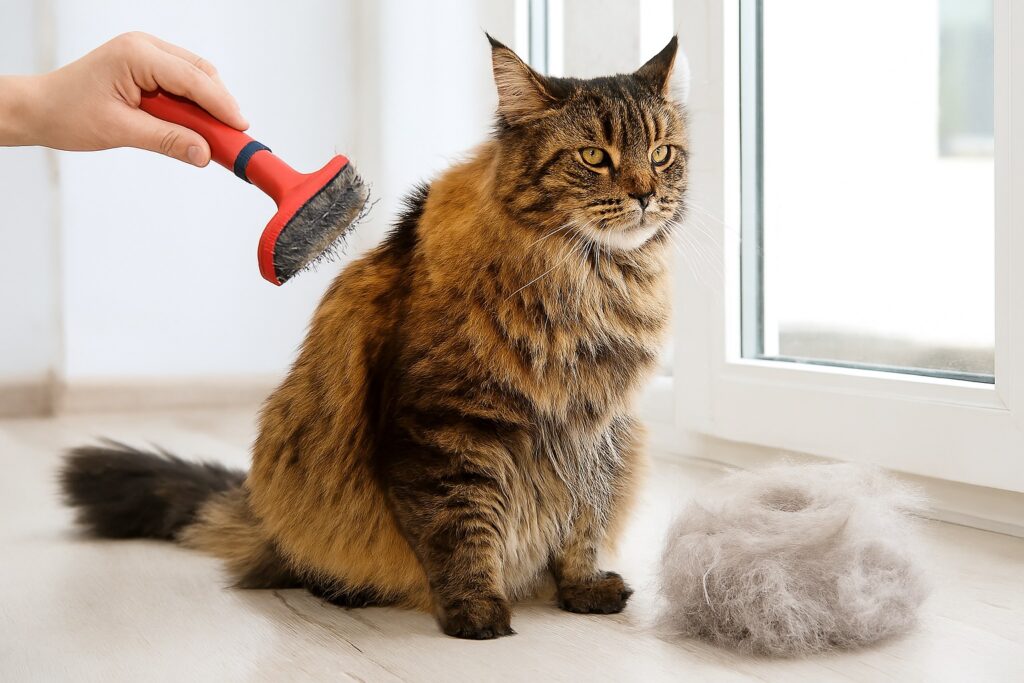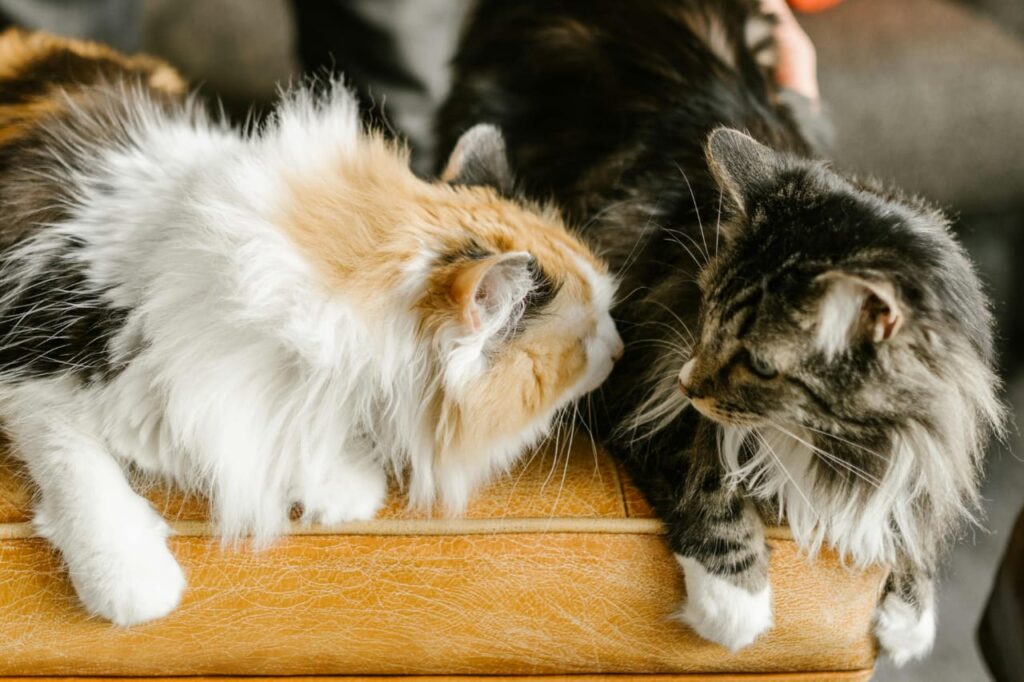
Maine Coons are one of the most popular cat breeds in the world, admired for their large size, gentle personality, and luxurious, fluffy coats. But with all that fur, one question often comes up: Do Maine Coon cats shed a lot?
The short answer is yes, Maine Coons do shed — but with the right care, it’s completely manageable. Their thick double coat is designed to protect them in colder climates, which naturally means they lose hair, especially during seasonal changes.
In this guide, we’ll cover everything you need to know about Maine Coon shedding:
- How much they shed compared to other cats
- Why they shed and what factors influence it
- Grooming tips to manage the fur around your home
- When to worry about excessive shedding
Table of Contents
2. Do Maine Coon Cats Shed?
Yes — Maine Coon cats do shed, and it’s a completely normal part of their grooming cycle. Like all cats, they naturally lose old or damaged hair to make room for healthy new growth. However, because Maine Coons are a long-haired breed with a thick double coat, their shedding is more noticeable than that of short-haired cats.
It’s also important to understand the pattern of shedding in Maine Coons:
- Seasonal Shedding:
Maine Coons typically shed more heavily during the spring and fall. In spring, they lose their dense winter coat to prepare for warmer weather. In the fall, they shed lighter fur as a new thick coat grows in for the colder months. - Year-Round Shedding:
Indoor Maine Coons may shed more consistently throughout the year because they’re less exposed to natural seasonal changes. The temperature and artificial lighting inside a home can cause a steady shedding cycle instead of distinct seasonal shifts.
In short, shedding is not a sign of poor health — it’s simply part of what makes a Maine Coon’s coat so full, beautiful, and functional.
3. How Much Do Maine Coon Cats Shed?
While every cat sheds to some degree, Maine Coons are known for their heavier shedding because of their size and coat type. These gentle giants have a thick double coat that keeps them warm in cold weather, but also means more hair will end up on your furniture, clothes, and floors.
Several factors influence how much a Maine Coon sheds:
- Coat Type (Thick Double Coat):
Their long outer layer and dense undercoat trap loose hairs, which naturally fall out during grooming or petting. - Seasonal Changes (Spring & Fall):
Shedding is heaviest when Maine Coons transition between their winter and summer coats. Expect an increase in fur around your home during these times. - Indoor vs Outdoor Living:
Indoor cats often shed steadily year-round because they live in controlled temperatures and artificial lighting. Outdoor or semi-outdoor cats may follow more noticeable seasonal patterns. - Diet & Health:
A poor diet, low in essential nutrients like omega-3 fatty acids, can lead to a dull coat and more shedding. Underlying health conditions such as allergies, skin issues, or stress can also increase fur loss.
On average, you can expect light daily shedding with seasonal spikes. With regular grooming and a balanced diet, though, it’s easy to keep their shedding under control.
Also read: The Ultimate Maine Coon Litter Box Guide
4. Do Maine Coons Shed More Than Other Cats?
Maine Coons are not the only cats that shed, but their shedding level is moderate to high compared to other breeds. Let’s look at how they stack up:
- Persian Cats (More Shedding):
Persians have long, ultra-dense coats that require daily grooming. They typically shed even more than Maine Coons, making coat maintenance more demanding. - Short-Haired Cats (Less Visible Shedding):
Breeds like the American Shorthair or British Shorthair shed too, but their shorter fur is less noticeable around the house. While they may shed similar amounts of hair, it doesn’t “pile up” the way a Maine Coon’s long fur can. - Hypoallergenic Breeds (Like Siberians):
Some people assume Siberian cats or other so-called “hypoallergenic breeds” shed less. In reality, they still shed, but their fur may cause fewer allergic reactions due to lower levels of the Fel d 1 protein. Maine Coons, however, are not hypoallergenic and do shed enough to trigger allergies in sensitive individuals.
In summary, Maine Coons shed more than short-haired cats, less than extremely long-haired breeds like Persians, and they are not allergy-friendly. Their shedding is noticeable but manageable with proper care.
Also read: Choosing the Right Litter Box for Maine Coons
Recommended Products for Managing Maine Coon Shedding
1. Grooming Tools
- Slicker Brush – Removes loose fur and prevents mats
- Deshedding Tool – Deep undercoat hairl/furr removal
2. Cat-Friendly Shampoos
- Hypoallergenic Cat Shampoo – Reduces dander and loose fur
- Deshedding Shampoo – Loosens shedding fur during bath time
3. Nutritional Supplements
- Omega-3 Fish Oil – Supports coat health and reduces shedding
- Hairball Control Treats – Helps cats pass ingested fur safely
4. Home Cleaning Tools
- Pet Hair Vacuum – Designed for heavy fur
- Lint Rollers & Fur Removers – Quick clean-up for clothes & furniture.
- Washable Cat Blankets/Covers – Keeps furniture fur-free.
These products solve the exact problems Maine Coon owners face (fur everywhere, grooming challenges, diet/health concerns).
5. Managing Maine Coon Shedding
While Maine Coons do shed, the good news is that their fur is very manageable with the right care routine. By staying on top of grooming and coat health, you can reduce loose hair and keep both your cat and your home comfortable.
Grooming Tips
- Brush your Maine Coon 2–3 times a week, and daily during heavy shedding seasons (spring and fall).
- Regular brushing prevents mats, removes loose hair, and keeps their coat shiny.
Best Grooming Tools
- Slicker brush – great for removing loose undercoat fur.
- Deshedding comb (like a Furminator) – helps reduce shedding deep in the coat.
- Wide-toothed comb – useful for gently detangling knots without pulling.
Occasional Bathing
- Bathing every few months with a cat-safe shampoo can loosen excess hair and reduce shedding.
- Avoid over-bathing, as it may dry out their skin and cause more fur loss.
Nutrition & Diet
- A diet rich in omega-3 and omega-6 fatty acids supports a healthy coat and reduces excessive shedding.
- High-quality cat food or supplements (with vet approval) can make a big difference.
Home Care
- Use lint rollers or pet-hair removers to keep clothes and furniture fur-free.
- A good vacuum designed for pet hair and litter will help maintain a clean home.
- Wash bedding, blankets, and cat furniture regularly to minimize fur buildup.
With these steps, shedding becomes less of a headache and more of a normal part of caring for your fluffy Maine Coon.
6. Shedding Seasons in Maine Coons
Maine Coon cats have a seasonal shedding cycle that reflects their natural adaptation to changing climates. Their thick double coat is designed to protect them in both cold and warm weather, so you’ll notice shedding increases during specific times of the year:
- Spring Shedding (Winter Coat Loss):
As the weather warms up, Maine Coons shed their dense winter undercoat. This is usually the heaviest shedding season, with clumps of fur coming out more easily during brushing. - Fall Shedding (Preparing for Winter):
In autumn, they lose their lighter summer fur as they grow a thick, insulating coat for the colder months. While not as intense as spring, it’s still noticeable. - Indoor Cats:
Cats kept indoors under controlled lighting and temperature may not follow such distinct seasonal patterns. Instead, they often shed more evenly year-round, though you may still see small seasonal increases.
Understanding these patterns can help you plan grooming routines and stay ahead of the heaviest shedding periods.
7. When to Worry About Shedding
Shedding is normal for Maine Coons, but there are times when excessive hair loss may signal an underlying problem. Knowing the difference between natural shedding and a health concern is important.
Signs of Excessive Shedding
- Bald patches or thinning fur
- Red, irritated, or flaky skin
- Constant scratching or over-grooming
- Sudden increase in fur loss outside of seasonal changes
Possible Causes
- Allergies (to food, fleas, or environmental factors)
- Stress (moving homes, new pets, or routine changes)
- Parasites (fleas, mites, or ticks)
- Nutritional deficiencies (lack of omega fatty acids, poor-quality food)
- Skin conditions or illness (such as fungal infections or thyroid issues)
What to Do
If your Maine Coon shows these symptoms, it’s best to consult a veterinarian. A professional check-up can help identify whether it’s just seasonal shedding or a sign of something more serious.
Regular grooming and a healthy diet can minimize shedding, but only a vet can rule out medical causes when hair loss becomes abnormal.
8. FAQs About Maine Coon Shedding
Q: Do Maine Coons shed a lot compared to regular cats?
A: Yes, Maine Coons shed more noticeably than most short-haired cats due to their thick double coat and long fur. However, they usually shed less than Persians and some other heavy-coated breeds.
Q: Are Maine Coon cats hypoallergenic?
A: No, Maine Coons are not hypoallergenic. They shed dander and produce the Fel d 1 protein, which commonly triggers cat allergies. If you’re sensitive, regular grooming and cleaning may help, but they won’t eliminate allergens completely.
Q: How can I reduce Maine Coon shedding in the house?
A: Brush your Maine Coon several times a week, feed them a diet rich in omega-3 fatty acids, and vacuum regularly. Using lint rollers and washing their bedding often also helps control loose fur.
Q: Do Maine Coons shed year-round or seasonally?
A: Both. They shed lightly year-round, but shedding increases significantly in spring and fall when they transition between summer and winter coats. Indoor cats may shed more evenly throughout the year.
Q: What is the best brush for Maine Coon cat shedding?
A: A slicker brush is great for removing loose undercoat hair, while a deshedding comb (such as a Furminator) helps reduce heavy shedding. A wide-toothed comb is also useful for detangling knots.
If you are a pet parent and loves writing about them, you can contribute and add your content in our site as a pet guest post














